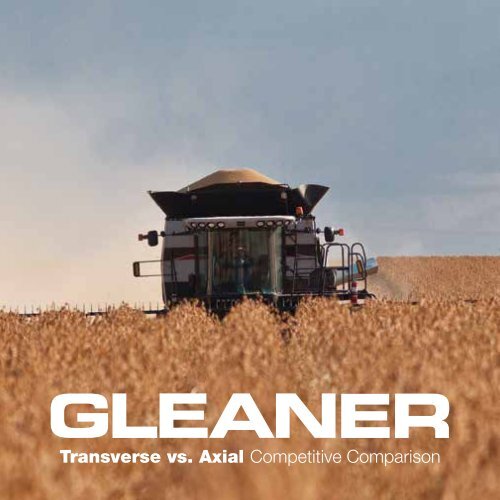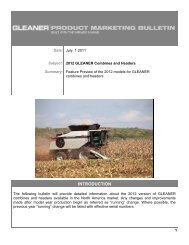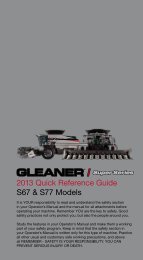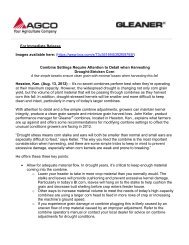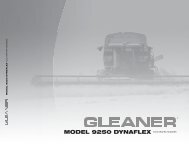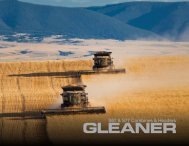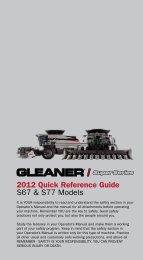Transverse vs. Axial Competitive Comparison
Transverse vs. Axial Competitive Comparison
Transverse vs. Axial Competitive Comparison
You also want an ePaper? Increase the reach of your titles
YUMPU automatically turns print PDFs into web optimized ePapers that Google loves.
<strong>Transverse</strong> <strong>vs</strong>. <strong>Axial</strong> <strong>Competitive</strong> <strong>Comparison</strong>
S67/S77 Updates for 2013New Premier heated and cooled seat for added operator comfort in any season.Addition of a rear feed-conveyor drive eliminates slipping and offers 50 percent more drivecapability, plus a 10 percent differential in rear-to-front feed conveyor speed minimizes anypinch point. These changes enhance feed conveyor capacity and deliver smoother, moreefficient, material flow. The improvements mean less draw on engine horsepower andprovide for longer belt life.NightSight Lighting optional w/ (4) HID lights in roof (8 total lights in roof) compared to sixon competitive models.Each combine now comes “guidance-ready” as a standard feature.New, deeper clean-grain cross-auger trough. The 8-inch cross auger has beendropped lower, below center line, to provide greater movement of grain to the elevatorhelping increase overall harvesting rates. Thicker elevator paddles also contributeto the 30 percent increase in clean-grain elevator capacity (5,000-bushel-per -hourmaximum elevator capacity rating).New, smaller-diameter straw chopper drum helps a greater volume of material movethrough, while reducing horsepower requirements by 5 HP.
Gleaner <strong>vs</strong>. Case IHMake/Model Gleaner S67 CIH 6130 Gleaner S77 CIH 7230Cooling SystemClass VI VI VII VIIHorsepower (hp) 314 320 370 380Engine displacement (L) 8.4 8.7 8.4 8.7Rated speed (rpm) 2,100 2,100 2,100 2,100MaintenanceReverseCooling fanNot availableReverseCooling fanCleaning required No Yes No YesVariable fan pitch feature available Yes No Yes NoAverage power savings @ 80°F (hp) 36 None 36 NoneProcessorTypeNatural FlowFeeding<strong>Axial</strong> w/fightingNatural FlowFeedingNot available<strong>Axial</strong> w/beaterRotor length (in) 90 110 90 110Degrees of threshing/separation 360° 156° 360° 180°Threshing & separation area (in²) 6,047 Not Published 6,047 Not publishedCleaning area (in²) 7,729 7,947 7,729 10,075Cleaning method Two-stage Single-stage Two-stage Single-stageAccelerator roll technology Yes No Yes No% of cleaning on performed on shoe66% @ rolls; 100% @ shoe 66% @ rolls; 100% @ shoe34% @ shoe34% @ shoeNo, up to 23%Slope sensitivityslopesApprox. power required for strawchopper (hp)Yes No, up to 23%slopes12%30 80-90 30 80-90
AdvantagesThe higher horsepower rating is lost with higher weight and parasitic loss of the machine.Combine requires periodic cleaning of radiator <strong>vs</strong>. no cleaning on reverse cooling.Gleaner is only the only combine with a variable pitch fan that can save 66% of power at80°F outside ambient temperature.Gleaner’s flat, even crop mat means the crop doesn’t have to change direction toaccommodate the rotor. All axial designs have a high wear area as the crop changes directioninto rotor intake. The beater in the CaseIH 7230 can break up cob and damage grain.The Gleaner 360° threshing and separation is substantially greater than CaseIH’s 156° or180° threshing and separator grate wrap at the same 30” rotor diameter.With Gleaner, 66% of the cleaning is done at the accelerator rolls of our exclusive 2-stagecleaning system. Our shoe is a secondary means not a primary as in the CaseIH where100% has to be cleaned at the shoe. Our accelerator rolls direct all of the crop through thehigh air blast to the front of the cascade pan in the same location every time. Over 40+%of the 7230 grain pan is solid at the front and is counted as sieve area which never getsany air so it does no functional cleaning. With the Gleaner, 100% of the shoe is receivingair from the upper air blast off of the accelerator rolls and the pneumatic area of the shoe.The CaseIH 7230 has a self-leveling shoe that is mechanical and can wear out and onlylevels to 12% slopes. Gleaner accelerator rolls can reduce slope sensitivity up to 23%.
Gleaner <strong>vs</strong>. Case IHMake/Model Gleaner S67 CIH 6130 Gleaner S77 CIH 7230Grain HandlingGrain bin capacity390 bu.standard300 bu., nooption390 bu.standard315 bu., nooptionPower-fold bin extensions Standard Optional Standard OptionalAverage unloading rates 4.0 bu./sec. 3.0 bu./sec. 4.0 bu./sec. 3.6 bu./sec.Time to unload grain bin (sec) 98 100 98 87.5Unloader design 2-auger swivel 3-auger turret 2-auger swivel 3-auger turretConstruction & WeightsMainframe constructionUnitized, Bolt-on Unitized, Bolt-onweldedweldedStraight-through shaftsYesNo, 90° gearboxesYesCVT drivegearboxesShipping weight - 2WD (lbs.) 29,740 33,100 29,740 36,800Weight of machine w/35’ header 59,750 58,161 59,750 62,761and full grain bin (lbs.)Power required to move shippingweight difference (hp)N/A 6.6 N/A 14.7
Advantages30% larger grain tank on S67 <strong>vs</strong>.CIH 6130 and 23% larger on the S77 <strong>vs</strong>. CIH 7230.Gleaner has largest on any class VI/VII combine.33% faster unloading rate on S67 <strong>vs</strong>. CIH 6130; 23% faster unloading on S77 <strong>vs</strong>. CIH7230Gleaner faster average unloading rate can unload the largest grain bin in the world in justover a minute and a half.Less wear, less horsepower required and less grain damage with Gleaner’s shallow 29°angle from clean grain cross auger to unloading auger.The Gleaner frame is stronger and lighter due to its exclusive welded unitized frame.Gleaner is more efficient and drives are easier to service.Unlike Gleaner, CaseIH combines have a weight issue and consume 14.7 hp. of its availablehorsepower just moving the bare combine weight difference of the 7230 through the fieldon a flat surface. Wet ground and hills compounds this issue. Though smaller, the CIH6130 platform still consumes 6.6 hp more of its available horsepower than the S67.
Gleaner <strong>vs</strong>. John DeereMake/Model Gleaner S67 JD S660 Gleaner S77 JD S670Cooling SystemClass VI VI VII VIIHorsepower (hp) 314 320 370 373Engine displacement (L) 8.4 9.0 8.4 9.0Rated speed (rpm) 2,100 2,200 2,100 2,200MaintenanceReverseCooling fanAir scoopReverseCooling fanAir scoopCleaning required No Yes No YesVariable fan pitch feature available Yes No Yes NoAverage power savings @ 80°F (hp) 36 None 36 NoneProcessorTypeNatural FlowFeeding<strong>Axial</strong> w/beaterNatural FlowFeeding<strong>Axial</strong> w/beaterRotor length (in) 90 123 90 123Degrees of threshing/separation 360° 180° 360° 180°Threshing & separation area (in²) 6,047 4,095 6,047 4,095Cleaning area (in²) 7,729 7,589 7,729 7,589Cleaning method Two-stage Single-stage Two-stage Single-stageAccelerator roll technology Yes No Yes No% of cleaning on performed on shoe66% @ rolls; 100% @ shoe 66% @ rolls; 100% @ shoe34% @ shoe34% @ shoeNo, up to 23%Slope sensitivityslopesApprox. power required for strawchopper (hp)Yes No, up to 23%slopesYes30 80-90 30 80-90
AdvantagesThe slightly higher horsepower rating with the John Deere is lost with higher weight andparasitic loss of the machine.John Deere’s air scoop requires periodic cleaning of radiator <strong>vs</strong>. no cleaning withGleaner’s reverse cooling.Gleaner is the only combine with a variable pitch fan which can save 66% of power at 80°Foutside ambient temperature.Gleaner’s flat, even crop mat means the crop doesn’t have to change direction. All axialdesigns have a high wear area as the crop changes direction into rotor intake. The beaterin the John Deere can break up cob and damage grain.The 360° degree threshing and separation with the Gleaner provides almost 48% more areathan John Deere.John Deere had to lengthen their shoe to compensate for no self-leveling device.Gleaner’s cleaning area is not only slightly larger, but we don’t rely on our shoe to do all thecleaning. In fact, we do 66% of our cleaning at the accelerator rolls.
Gleaner <strong>vs</strong>. John DeereMake/Model Gleaner S67 JD S660 Gleaner S77 JD S670Grain HandlingGrain bin capacity390 bu.standard300 bu. 390 bu.standard300 bu.Power-fold bin extensions Standard Optional Standard OptionalAverage unloading rates 4.0 bu./sec. 3.3 bu./sec. 4.0 bu./sec. 3.3 bu./sec.Time to unload grain bin (sec) 98 91 98 91Unloader design 2-auger swivel 3-auger turret 2-auger swivel 3-auger turretConstruction & WeightsMainframe constructionUnitized, Bolt-on Unitized, Bolt-onweldedweldedStraight-through shaftsYesNo, 90° gearboxesYesNo, 90° gearboxesShipping weight - 2WD (lbs.) 29,740 38,147 29,740 44,430Weight of machine w/35’ header 59,750 63,830 59,750 70,113and full grain bin (lbs.)Power required to move shippingweight difference (hp)N/A 16.4 N/A 30.8
AdvantagesThe grain bin on Gleaner S67/S77 is 30% larger than the John Deere S660/S670. Gleanerhas largest grain bin on any class VI/VII combine.Gleaner has 21% faster unloading rate.Gleaner has a faster average unloading rate that can unload the largest grain bin in theworld in just over a minute and a half.Less wear, less horsepower required and less grain damage with Gleaner’s shallow 29°angle from clean grain cross auger to unloader auger.The Gleaner frame is stronger and lighter due to its exclusive welded unitized frame.Gleaner is more efficient and drives are easier to service.Unlike Gleaner, John Deere has a huge compaction issue and consumes a large amountof horsepower just to move it through the field on a flat surface. Wet ground and hillscompounds this issue.
EfficiencyExtra weight requires more horsepower to achieve the same result as a lighter machine.With the 2011 John Deere 9770 ¹ , it’s nearly the equivalent of towing a John Deere 5055D,2-wheel drive tractor behind your Gleaner any time you take the machine out in the field.And unfortunately, the new 2012 John Deere S670 ¹ weighs almost 16,000 lbs. more thana Gleaner S77. This extra weight requires 30 hp just to move the laden weight difference ofthe two machines through the field. That’s the equivalent of pulling a John Deere 6170R,2-wheel drive tractor behind your Gleaner.For the 2012 CaseIH 7230 ¹ you’ll have to hook up a CaseIH Farmall Series 85U tractorwith MFD and a cab. And for the 2011 CaseIH 7120 ¹ , strap on a CaseIH Farmall Series80 tractor with 2-wheel drive and ROPS behind your Gleaner to travel up every hill,through every mud puddle and down every road.And for the 2012 New Holland 9060 ² , your looking at pulling a New Holland T4.75 Powerstar tractor with 4-wheel drive and a cab with you behind your Gleanereverywhere you go.HeaderWeight (35’draper) (lbs.)Year Brand/ModelsShippingWeight (lbs.)2012 Gleaner S77 2WD 29,740 6,610 36,3502011 JD 9770 2WD 32,765 7,683 40,4482012 JD S670 2WD 44,430 7,683 52,1132011 CIH 7120 2WD 35,080 7,061 42,1412012 CIH 7230 2WD 36,800 7,061 43,8612012 NH 9060 2WD 35,150 7,396 ² 42,546Weight w/ Header(lbs.)NOTE: Dimensions taken from manufaturer’s published product literature. ¹ Total weight with 35’ draper header attached. ² 36’ draperengineering calculation of rolling resistance (CRR) (an estimated 0.00196) by the weight difference in the Difference <strong>vs</strong>. Gleaner column.
2012 JD S670+ 15,763 lbs.2011 JD 9770 STS+ 4,098 lbs.2012 CaseIH 7230+ 7,511 lbs.2011 CaseIH 7120+ 5,791 lbs.2012 NH 9060+ 6,196 lbs.Difference <strong>vs</strong>.Gleaner (lbs.)PowerRequired † (hp)Grain TankCapacityGrain Weight ³(lbs.)Total Weight(lbs.)NA NA 390 bu. 23,400 59,7504,098 8.0 300 bu. 18,000 58,44815,763 30.8 300 bu. 18,000 70,1135,791 11.35 315 bu. 18,900 61,0417,511 14.7 315 bu. 18,900 62,7616,196 12.1 315 bu. 18,900 61,446header. ³ Estimated @ 60 lbs. per bushel @ 17% moisture (soybeans). † Horsepower requirement achieved by multiplying an
Transport HeightEven with one of the largest grain bin capacities on any combine in the industry, theGleaner S67/S77’s unique optional power foldable 390-bushel bin extensions folddown in under 20 seconds with the flip of a switch to an overall height of 12.41 feet.This can make a big difference when transporting or storing the combine.Gleaner S77390 bu.12.41 feetJD 9770 STS300 bu.14.83 feetCaseIH 7120315 bu.13.41 feet
Threshing AreaOnce crop enters our rotor and threshingbegins, crop separates and falls from the rotorthrough a 360-degree cage. The wrap of thiscage is important because it is crucial thatcrop only be threshed long enough to releaseit from heads, pods or cobs. Crop that remainsin the threshing area can get damaged. Our360-degree wrap means grain exits the rotorcage once it is threshed. Our competitors’designs are closed on top keeping free graininside where it continues to impact the rotor’sthreshing elements.
Natural FlowWe call our feeding system Natural Flow because the crop materialflows straight into the combine, straight into and around the rotorand straight out the back. Our competitors shift the crop’s path andchange its direction requiring more horsepower to do the samethreshing and separating as the Gleaner.
Feeder HouseWhile a Gleaner has a narrower feeder house than other combines, the openingthat feeds the rotor is actually wider. This is because Gleaner does not narrow orcompress the crop mat as this would cause wear, bunching and crop damage.
FeedingOur competitors’ designs, which include either a beater or “elephant ears,” haveto stuff, bunch and sheer the crop mat in order to feed their rotor. Our rotor is fednaturally and directly to ensure even and consistent threshing.
Slope SensitivityA Gleaner propels grain through the air blast and onto the grain pan. Because Gleanerdoes not rely on gravity to move the grain, the direction of the grain stays consistentevenon slopes up to 23%. Competitors require the expense, complexity and wear ofself-leveling shoes or undercarriages to match Gleaner.
Air VelocityOur transverse system drops material in the same position parallel to the fan. Thismeans every piece of grain is always hit with the same velocity of air. With an axialrotor, grain can drop at any point on the rotor meaning grain that drops early is hit withone air velocity while grain that drops later is hit with another velocity. The ability topreclean the grain before the shoe and use the shoe as a highly effective secondarycleaning system is why it can obtain such clean grain with low loss levels.The same issue of where grain drops from the rotor affects the effectiveness of theshoe. The Gleaner always drops its grain and material in the same position. <strong>Axial</strong>combines tend to unevenly distribute grain to the cleaning shoe. This can cause grainloss out the back of the combine.
Shoe OverloadMany axial combines due to concave design tend to overload the cleaning shoe onone side of the machine.As the rear portion of the shoe becomes over loaded with grain and MOG (materialother than grain), grain can be carried out the back of the combine.With Gleaner, after grain falls from the processor, a set of distribution augers metersthe crop mat into a consistent ribbon of material. The crop is then propelled by theaccelerator rolls, through an air blast at four times the speed of freefall and onto thegrain pan. These distribution augers insure a uniform ribbon of crop feeding into theremainder of the cleaning system—no matter where crop falls from the processor.
AGCO • 4205 River Green Parkway, Duluth, GA 30096 • www.gleanercombines.comAGCO may at any time, and from time to time, for technical or other necessary reasons, modify any of thedata, specifications or warranty of the products described herein. Some equipment shown may be optional.Attention: Photographs in this publication may show protective shields or guards open or removed for thepurposes of illustration. Be certain all shields and guards are in place during operation.AGCO & Gleaner are registered trademarks of AGCO Corporation • © 2012 AGCO • GL12B004ST (10) 10 PD


